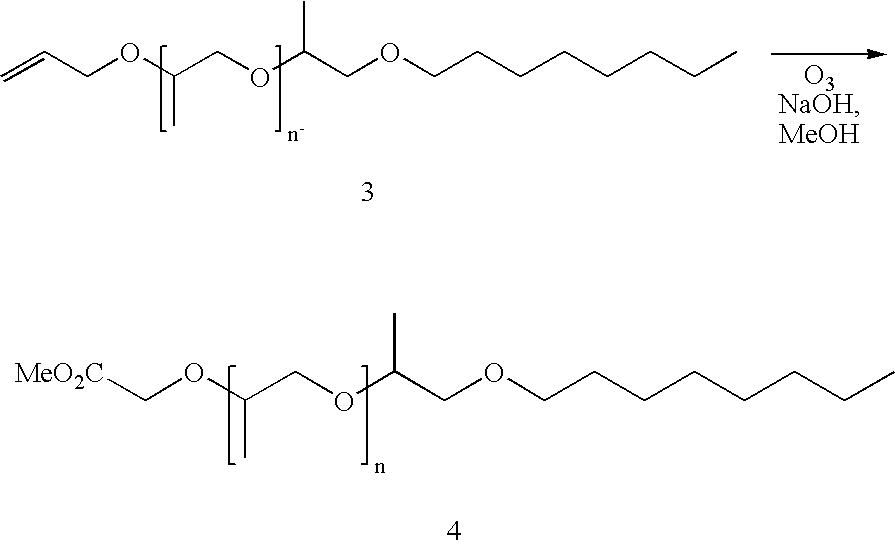Alkylpolypropyleneoxide amidotriamines and method of using same
a technology of alkylpolypropyleneoxide and amidotriamine, which is applied in the field of ophthalmology, can solve the problems of inability to clean and disinfect the lens properly, loss of infected eye(s) if left untreated, and relatively rapid soiled, so as to facilitate the removal of deposits and improve the cleaning effect. , the effect of disinfecting the lens
- Summary
- Abstract
- Description
- Claims
- Application Information
AI Technical Summary
Benefits of technology
Problems solved by technology
Method used
Image
Examples
example 1
[0033] The following formulation may be utilized as a contact lens disinfecting solution. The formulation would contain one or more compounds of formula (I) as a disinfectant.
Formulation Numbers / ConcentrationsComponentFID 93407FID 84509Sorbitol1.2%—Sodium Citrate0.6%—Boric Acid0.18%Sodium chloride0.1%0.49%Tetronic 13040.1%—EDTA0.05% 0.05%AMP (95%)0.45% —pH7.87.0
example 2
[0034] The tests described below were condu cted to evaluate the antimicrobial activity of the compounds and composi tions of the present invention. To perform these tests, the bacteria Serratia marcescens ATCC 13880 and Staphylococcus aureus ATCC 6538 were cultured on soybean casein digest agar (SCDA) slants. The yeast Candida albican was inculated was cultured on Sabouraud Dextrose Agar slants. Surface growth of the three microorganisms was harvested with phosphate buffered saline containing Polysorbate 80. The microbial suspensions were adjusted spectrophotometrically to a concentration of approximately 1.0×108 colony forming units / mL (CFU / mL).
[0035] Antimicrobial compounds were prepared at target concentrations in selected vehicles. Ten mL of test solution was inoculated with 0.1 mL of the appropriate microbial suspension so that the test solution contained approximately 1.0×106 CFU / mL. The tubes were thoroughly mixed and kept at room temperature during the test.
[0036] At six ...
example 3
[0041] The test procedures described in Example 2 above were used to evaluate the amidotriamine compounds AL-9201, AL-9548, AL-9552, and AL-9577 at a concentration of 0.001% in water and FID 84509. The results are presented in Tables 5 and 6, below:
TABLE 5Disinfection Efficacy of 0.001% Amidotriamine Compounds in WaterTimeLog10 Reduction of SurvivorsMicroorganism(hrs)AL-9201AL-9548AL-9552AL-9577C. albicans64.12.40.40.1245.9a5.91.60.3S. marcescens64.34.36.13.4245.44.73.04.2S. aureus63.23.32.42.1242.25.25.23.6
aUnderlined number indicates no survivors (<10 cfu / ml) recovered
[0042]
TABLE 6Disinfection Efficacy of 0.001% AmidotriamineCompounds in FID 84509TimeLog10 Reduction of SurvivorsMicroorganisms(hrs)AL-9201AL-9548AL-9552AL-9577C. albicans60.10.10.00.0240.10.10.20.0S. marcescens63.22.53.12.2243.83.63.23.2S. aureus60.00.42.00.0242.72.92.80.0
The results further demonstrate the strong antimicrobial activity and salt sensitivity of these compounds.
PUM
| Property | Measurement | Unit |
|---|---|---|
| frequency | aaaaa | aaaaa |
| solubility | aaaaa | aaaaa |
| Solubility | aaaaa | aaaaa |
Abstract
Description
Claims
Application Information
 Login to View More
Login to View More - R&D
- Intellectual Property
- Life Sciences
- Materials
- Tech Scout
- Unparalleled Data Quality
- Higher Quality Content
- 60% Fewer Hallucinations
Browse by: Latest US Patents, China's latest patents, Technical Efficacy Thesaurus, Application Domain, Technology Topic, Popular Technical Reports.
© 2025 PatSnap. All rights reserved.Legal|Privacy policy|Modern Slavery Act Transparency Statement|Sitemap|About US| Contact US: help@patsnap.com



